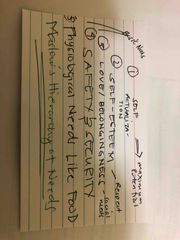![]()
![]()
![]()
Use LEFT and RIGHT arrow keys to navigate between flashcards;
Use UP and DOWN arrow keys to flip the card;
H to show hint;
A reads text to speech;
31 Cards in this Set
- Front
- Back
|
People are driven to do certain behaviors based on evolutionary programmed instincts. |
Instinct Theory |
|
|
Physiological or psychological state of being awake and reactive to stimuli |
Arousal |
|
|
Lower arousal levels are best for? |
Cognitive tasks |
|
|
Higher levels of arpusal are optimal for activities? |
Needing stamina and endurance |
|
|
People perform actions of behavior in order to maintain an optimal level of arousal |
Arousal Theory |
|
|
People try to act in order to relieve internal tensions ( drives ) |
Drive-reduction theory |
|
|
Are those that motivate us to fulfill non-biological, emotional, “learned” desires. |
Secondary Drives |
|
|
Primary drives are those that motivate us to sustain necessary _________. |
Biological Processes |
|
|
Enumerate the maslow’s hierarchy of needs. |

Back (Definition) |
|
|
The three universal needs to be met in order to develop healthy relationships with oneself and others accdg to Self-Determination Theory |
Autonomy, Competence and Related ness |
|
|
Behavior is motivated thru positive reinforcement or positive punishment |
Incentive theory |
|
|
It states that the amount of motivation needed to reach goal is the result of both the individual’s expectation of success in reaching the goal and the degree to which he or she values succeeding at the goal. |
Expectancy-Value theory |
|
|
Decrease in perceived drug effects overtime |
Tolerance |
|
|
Decrease in perceived drug effects overtime |
Tolerance |
|
|
Withdrawal effects would be opposite of the the drug effects is governed by? |
Opponent-process theory |
|
|
The theory explains that when a drug is taken repeatedly, the body will attempt to counteract the effects of the drug by changing its physiology. |
Opponent-process theory |
|
|
The purpose or driving force behind our actions |
Motivation |
|
|
It results in external, tangible rewards. |
Extrinsic Motivation |
|
|
The purpose or driving force behind our actions |
Motivation |
|
|
It results in external, tangible rewards. |
Extrinsic Motivation |
|
|
Motivation comes from within oneself and it is driven by interest in a task ot pure enjoyment |
Intrinsic motivation |
|
|
Can include rewards for showing a desired behavior or avoiding punishment if the desired behavior is not achieved. |
Extrinsic motivation |
|
|
What is the kluver-bucy syndrome? |
Bilateral malfunction of amygdala |
|
|
The purpose or driving force behind our actions |
Motivation |
|
|
It results in external, tangible rewards. |
Extrinsic Motivation |
|
|
Motivation comes from within oneself and it is driven by interest in a task ot pure enjoyment |
Intrinsic motivation |
|
|
Can include rewards for showing a desired behavior or avoiding punishment if the desired behavior is not achieved. |
Extrinsic motivation |
|
|
What is the kluver-bucy syndrome? |
Bilateral malfunction of amygdala |
|
|
Results of bilateral malfunction of amygdala |
Hypersexuality, hyper orality and disinhibited bahavior |
|
|
You cannot infer conclusions about the characteristic of an individual based upon a certain behavior to a certain situation. |
Situational Approach |
|
|
The inability to feel pleasure |
Anhedonia |

